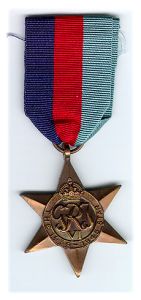
|
World War 2 stars and medals
|
| [Home] | [Medals Home] | [glossary] |
Eight different campaign stars were issued for the Second World War. Apart from some Commonwealth issues, these were issued unnamed. It was decided that the maximum number of stars that could be earned by any one person was five, while those who qualified for more received a clasp to be sewn on to the ribbon of the appropriate star.
Only one clasp per ribbon was permitted which was the first to be earned after qualifying for the star.
The stars are listed with the associated clasps in brackets:
The ribbons are believed to have been designed by King George VI personally and have symbolic significance in each case. When ribbons alone are worn, the clasp is denoted by a silver rosette, the Battle of Britain by represented by a gilt rosette.
 |
Date: | 1945 |
| Campaign: | Second World War 1939-45 | |
| Branch of Service: | British and Commonwealth Forces | |
| Ribbon: | Equal stripes of dark blue, red and light blue symbolising the Royal Navy, Army and Royal Air Force respectively. | |
| Metal: | Bronze | |
| Size: | Height 44mm; max. width 38mm | |
| Description: | The six pointed star has a circular centre with the GRI/VI monogram, surmounted by a crown and inscribed THE 1939-45 STAR round the foot. | |
| Clasps: | Battle of Britain |
The first in a series of eight bronze stars issued for service in the Second World War, it was awarded to personnel who had completed six months’ service in specified operational commands overseas, between 3rd September 1939 and 2nd September1945, though in certain cases the minimum period was shortened. Any service curtailed by death, injury or capture also qualified, as did the award of a decoration or a mention in despatches. The clasp awarded to RAF aircrew for action during the Battle of Britain was denoted by a gilt rosette when the ribbon was worn alone.
back to top |
Date: | 1945 |
| Campaign: | Atlantic 1939-45 | |
| Branch of Service: | Royal and Commonwealth Navies | |
| Ribbon | Watered silk blue, white and green representing the ocean | |
| Metal: | Bronze | |
| Size: | Height 44mm; max. width 38mm | |
| Description: | The six pointed star has a circular centre with the GRI/VI monogram, surmounted by a crown and inscribed THE ATLANTIC STAR | |
| Clasps: | Air Crew Europe and France and Germany |
This star was awarded in the Royal Navy for six months’ service afloat between 3rd September 1939 and 8TH May 1945 in the Atlantic or home waters, and to personnel employed in the convoys to North Russia and the South Atlantic. Personnel must have already qualified for the 1939-45 Star with the qualifying period for this not counting towards the Atlantic Star. Merchant Navy personnel also qualified, as did the RAF and Army (maritime gunners and aircrews-the latter only requiring 2 months service) who served afloat. In the last six months of operational service up to 8th May 1945, the Atlantic Star was awarded but not the 1939-45 Star. Entitlement to the France and Germany or Air Crew Europe stars was denoted by clasps to that effect, if the Atlantic Star was previously awarded. Only one clasp could be worn.
back to top
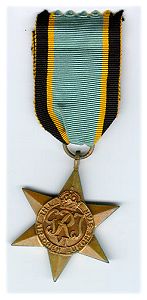 |
Date: | 1945 |
| Campaign: | Air operations over Europe 1939-44 | |
| Branch of Service: | RAF and Commonwealth aircrew | |
| Ribbon | Pale blue (the sky) with black edges (night flying) and a narrow yellow stripe on either side (enemy searchlights) | |
| Metal: | Bronze | |
| Size: | Height 44mm; max. width 38mm | |
| Description: | The six pointed star has a circular centre with the GRI/VI monogram, surmounted by a crown and inscribed THE AIRCREW EUROPE STAR | |
| Clasps: | Atlantic or France and Germany |
Awarded for operational flying from UK bases over Europe, for a period of two months between 3rd September 1939 and 4th June 1944. Entitlement to either the Atlantic or France and Germany Star was denoted by the appropriate clasp. This star is by far the most coveted of all of the Second World War Stars. Officially named stars to South Africans are the rarest of all Second World War medals.
back to top |
Date: | 1945 |
| Campaign: | Africa 1940-43 | |
| Branch of Service: | British and Commonwealth Forces | |
| Ribbon | Pale buff symbolising the sand of the desert, with a broad red central stripe, a dark blue stripe on the left and a light blue stripe on the right symbolising the three services. | |
| Metal: | Bronze | |
| Size: | Height 44mm; max. width 38mm | |
| Description: | The six pointed star has a circular centre with the GRI/VI monogram, surmounted by a crown and inscribed THE AFRICA STAR | |
| Clasps: | North Africa 1942-43, 8th Army and 1st Army |
Awarded for entry into an operational area in North Africa between 10th June 1940 (The date of Italy’s declaration of war} and 12th May 1943 {the end of operations in North Africa), but service in Abyssinia (Ethiopia), Somaliland, Eritrea and Malta also qualified for the award. A silver numeral 1 or 8 worn on the ribbon denoted service with the First or Eighth Army between 23rd October 1942 and 23rd May 1943. A clasp inscribed North Africa was awarded to personnel of the Royal Navy Inshore Squadrons and Merchant Navy vessels which worked inshore between these dates. RAF personnel also qualified for this clasp, denoted by a silver rosette on the ribbon alone.
back to top |
Date: | 1945 |
| Campaign: | Pacific area 1941-45 | |
| Branch of Service: | British and Commonwealth forces | |
| Ribbon | Dark green (the jungle) with a central yellow stripe (the beaches), narrow stripes of dark and light blue (Royal Navy and RAF) and wider stripes of red (Army) at the edges. | |
| Metal: | Bronze | |
| Size: | Height 44mm; max. width 38mm | |
| Description: | The six pointed star has a circular centre with the GRI/VI monogram, surmounted by a crown and inscribed THE PACIFIC STAR | |
| Clasps: | Burma |
Awarded for operational service in the Pacific theatre of war from 8th December 1941 to 15th August 1945. Service with the Royal and Merchant Navies in the Pacific Ocean, Indian Ocean and South China Sea and land service in these areas also qualified. Personnel qualifying for both Pacific and Burma Stars got the first star and a clasp in respect of the second.
back to top |
Date: | 1945 |
| Campaign: | Burma 1941-45 | |
| Branch of Service: | British and Commonwealth Forces | |
| Ribbon | Three equal bands of dark blue (British forces), red (Commonwealth forces) and a dark blue. The dark blue bands each have at their centres a stripe of bright orange (the Sun) | |
| Metal: | Bronze | |
| Size: | Height 44mm; max. width 38mm | |
| Description: | The six pointed star has a circular centre with the GRI/VI monogram, surmounted by a crown and inscribed THE BURMA STAR | |
| Clasps: | Pacific |
Qualifying service in the Burma campaign counted from 11th December 1941 and included service in Bengal or Assam from 1st May 1942 to 31st December 1943, and from 1st January 1944 onwards in these parts of Bengal or Assam east of the Brahmaputra. Naval service in the Eastern bay of Bengal, off the coasts of Sumatra, Sunda and Malacca also counted.
back to top |
Date: | 1945 |
| Campaign: | Italy 1943-45 | |
| Branch of Service: | British and Commonwealth forces | |
| Ribbon | Five equal stripes of red, white, green, white and red (the Italian National colours) | |
| Metal: | Bronze | |
| Size: | Height 44mm; max. width 38mm | |
| Description: | The six pointed star has a circular centre with the GRI/VI monogram, surmounted by a crown and inscribed THE ITALY STAR | |
| Clasps: | None |
Awarded for operational service on land in Italy, Sicily, Greece, Yugoslavia, the Aegean area and Dodecanese islands, Corsica, Sardinia and Elba at any time between 11th June 1943 and 8th May 1945.
back to top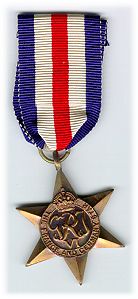 |
Date: | 1945 |
| Campaign: | France and Germany 1944-45 | |
| Branch of Service: | British and Commonwealth forces | |
| Ribbon | Five equal stripes of blue, white, red, white and blue (the national colours of the United Kingdom, France and the Netherlands | |
| Metal: | Bronze | |
| Size: | Height 44mm; max. width 38mm | |
| Description: | The six pointed star has a circular centre with the GRI/VI monogram, surmounted by a crown and inscribed THE FRANCE AND GERMANY STAR | |
| Clasps: | Atlantic |
Awarded for operational service in France, Belgium, the Netherlands or Germany from 6th June 1944 to 8th May 1945. Service in the North Sea, English channel and Bay of Biscay in connection with the campaign in northern Europe also qualified. Prior eligibility for the Atlantic or Air Crew Europe Stars entitled personnel only to a clasp for France and Germany. Conversely a first award of the France and Germany Star could earn an Atlantic clasp.
back to top
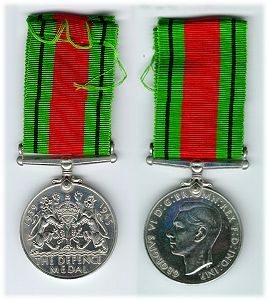
|
Date: | 1945 |
| Campaign: | Second World War 1939-45 | |
| Branch of Service: | British and Commonwealth forces | |
| Ribbon | Two broad stripes of green (this green and pleasant land) superimposed by narrow stripes of black (the black-out), with a wide stripe of orange (fire-bombing) in the centre. | |
| Metal: | Cupro-nickel or silver | |
| Size: | 36mm | |
| Description: | (Obverse) the uncrowned head of King George VI, (reverse) two lions flanking an oak sapling crowned with the dates at the sides and wavy lines representing the sea below. The words THE DEFENCE MEDAL appears in the exergue. |
Awarded to service personnel for three years service in a non-operational area (e.g. India) or six months service overseas in territories subjected to air attack or otherwise closely threatened. Personnel of Anti-Aircraft Command, RAF ground crews, Dominion forces stationed in the U.K., the Home Guard, Civil Defence, National Fire service and many other civilian units qualified for the medal. The medal was generally issued unnamed in cupro-nickel, but the Canadian version was struck in silver.
back to top
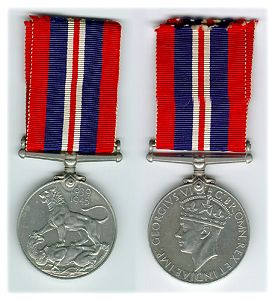 |
Date: | 1945 |
| Campaign: | Second World War 1939-45 | |
| Branch of Service: | British and Commonwealth forces | |
| Ribbon | Narrow red stripes in the centre, with a narrow white stripe on either side, broad red stripes at either edge and two intervening stripes of blue | |
| Metal: | Cupro-nickel or silver | |
| Size: | 36mm | |
| Description: | (Obverse) effigy of King George VI; (reverse) a triumphant lion trampling a dragon symbolising the Axis Powers | |
| Clasps: | None |
All fulltime personnel of the armed forces wherever they were serving, so long as they had served for at least 28 days between 3rd September 1939 and 2nd September 1945 were eligible for this medal. It was granted in addition to the campaign stars and the Defence Medal. E few categories of civilians, such as war correspondents and ferry pilots who had flown in operational theatres, also qualified. No clasps were issued with this medal but a bronze oak leaf denoted a mention in despatches. The medal was struck in cupro-nickel and issued unnamed, but those issued to Australian and South African personnel were officially named. The Canadian version of this medal was struck in silver.
back to top